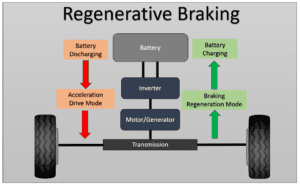Table of Contents
Introduction
In the ever-evolving world of electric vehicles (EVs), innovations continue to shape the way we think about transportation. One such revolutionary concept is regenerative braking, a technology that not only enhances the efficiency of EVs but also contributes significantly to reducing environmental impact. In this blog post, we will delve into the intricacies of this tech, exploring how it works, its advantages, and disadvantages, and the exciting future it holds.
How Does Regenerative Braking Work?
Photo: evup.com
Regenerative braking is a clever mechanism that allows electric vehicles to recover energy while slowing down or coming to a stop. Unlike traditional braking systems that convert kinetic energy into heat, this system captures this energy and stores it for later use. When the driver applies the brakes, the electric motor shifts into reverse mode, acting as a generator. This generator converts the vehicle’s kinetic energy back into electrical energy, which is then fed back into the battery for storage. This process not only slows down the vehicle but also recharges the battery, extending the driving range of the EV.
Advantages of Regenerative Braking
It offers several compelling advantages, making it a key feature in modern electric vehicles:
- Increased Energy Efficiency: By harnessing energy that would otherwise be wasted as heat, regenerative braking significantly improves the overall energy efficiency of electric vehicles.
- Extended Driving Range: The regenerated energy adds extra miles to the driving range, reducing the frequency of recharging and enhancing the EV’s practicality for daily use.
- Reduced Brake Wear: As it reduces the reliance on mechanical brakes, it minimizes wear and tear on the braking system, leading to lower maintenance costs.
- Environmental Benefits: By conserving energy and reducing emissions, it contributes to a cleaner environment, aligning with the global push for sustainable transportation solutions.
Disadvantages of Regenerative Braking
While it is a groundbreaking technology, it does have its limitations:
- Limited Effectiveness at High Speeds: It is most effective at lower speeds. At higher speeds, traditional friction brakes are often needed to provide sufficient stopping power.
- Complexity and Cost: Implementing these systems can be complex and costly, especially for manufacturers, potentially impacting the overall cost of electric vehicles.
- Dependency on Battery State: The efficiency of this system depends on the state of the battery. If the battery is fully charged, it might be limited until there is room for more energy storage.
The Future of Regenerative Braking
The future of this tech holds immense promise. Researchers and engineers are continually working to address its limitations and enhance its efficiency. As technology advances, we can expect to see:
- Improved Efficiency at High Speeds: Ongoing research aims to enhance regenerative braking systems, making them more effective at higher speeds, thereby reducing the reliance on traditional friction brakes.
- Integration with Other Technologies: It is likely to be integrated with other emerging technologies, such as advanced energy storage solutions and artificial intelligence, further optimizing its performance.
- Standardization and Cost Reduction: As the technology becomes more commonplace, standardization and increased production volumes are expected to reduce costs, making it more accessible to a broader range of consumers.
Conclusion
Regenerative braking stands as a testament to human ingenuity, transforming wasted energy into a valuable resource. Despite its current limitations, ongoing research and development efforts are paving the way for a future where electric vehicles are more efficient, affordable, and environmentally friendly. As the automotive industry continues to embrace regenerative braking and its advancements, we can look forward to a greener and more sustainable tomorrow, one regenerative brake at a time.
By embracing regenerative braking, we are not only redefining the way we drive but also reshaping the future of transportation. As advancements continue to unfold, the road ahead seems promising, steering us toward a more sustainable and energy-efficient world.





